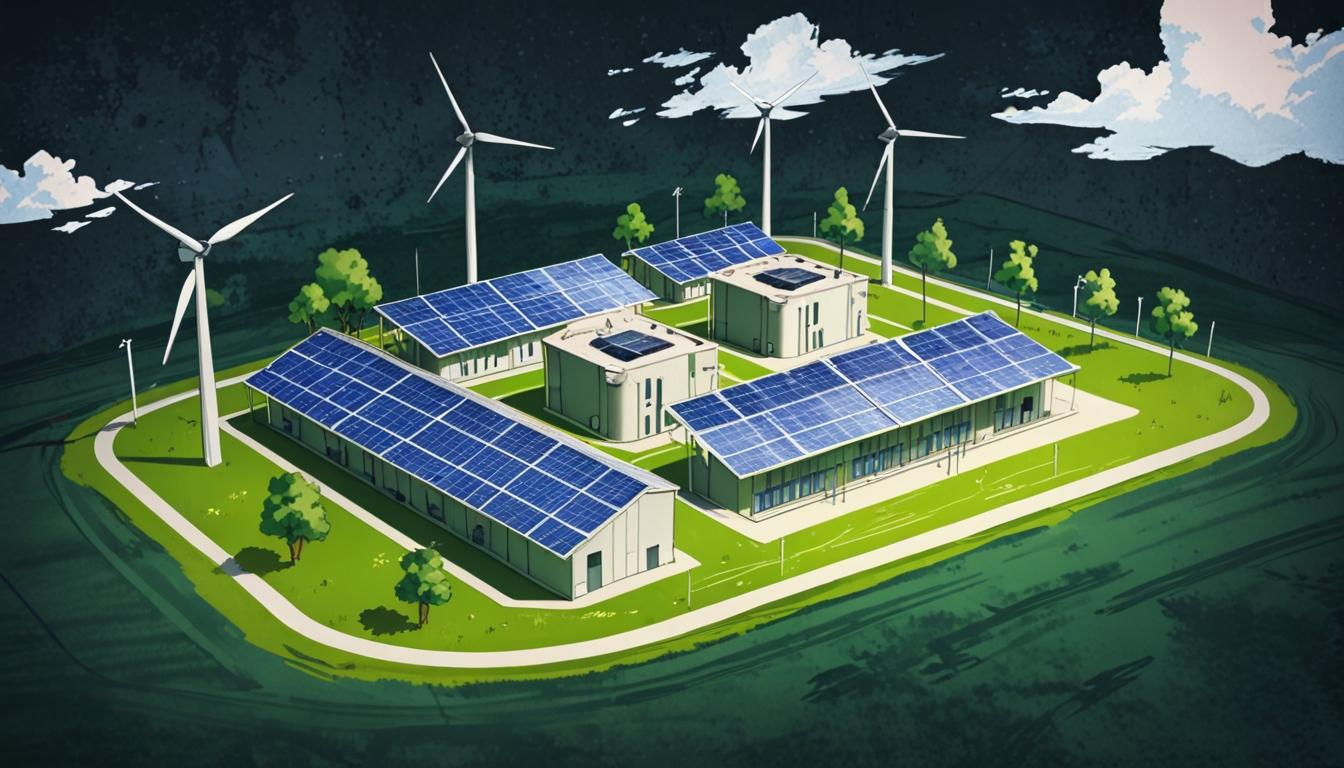As businesses shift towards cloud computing, significant advances in data storage and management are promising a more sustainable future, reducing carbon emissions and enhancing resource efficiency.
In the current digital landscape, the reliance on cloud computing is becoming increasingly pronounced among businesses and individuals, driving a significant transformation in data storage and management practices. This shift is particularly relevant as organisations prioritise sustainability within their operational frameworks. Recent reports highlight how cloud computing serves as an effective means to reduce carbon footprints and promote environmental accountability, with notable implications for energy usage and emissions reductions.
Historically, the reliance on traditional IT infrastructure posed substantial environmental challenges. Enterprises primarily depended on physical data centres that demanded vast amounts of energy for operation, maintenance, and cooling. This high consumption of electricity led to significant greenhouse gas emissions and raised operational costs, intensifying environmental concerns, particularly in light of global warming.
Transitioning to cloud computing has provided an opportunity to mitigate these issues. Key players in the cloud computing space, including Amazon Web Services (AWS), Microsoft Azure, and Google Cloud, have made significant investments in developing energy-efficient data centres. These facilities are designed to optimise power usage and minimise emissions, thereby centralising IT resources for improved efficiency. This alignment with sustainability goals is evidenced by several factors:
Modern cloud data centres employ advanced cooling systems and AI-driven energy optimisation methods to markedly decrease electricity consumption. Unlike traditional configurations, cloud solutions effectively allocate resources based on real-time demands, preventing instances of energy waste. Additionally, by utilising cloud computing, businesses can decrease their reliance on physical servers, thereby diminishing electronic waste. Provider-managed infrastructure updates extend the lifecycle of hardware, while also reducing the frequency of replacements.
Cloud computing’s scalability allows businesses to adjust resources in accordance with demand, ensuring only requisite energy is consumed. This capability contributes to a reported decrease in carbon emissions by as much as 98% compared to traditional data centre operations, underscoring the sustainability benefits associated with cloud solutions.
Innovative advancements within the cloud computing environment are further fuelling sustainability efforts. Leading cloud providers are investing in green data centres powered by renewable sources, including solar, wind, and hydroelectric power. These facilities are equipped with energy-efficient technologies aimed at minimising consumption.
The application of artificial intelligence (AI) and machine learning (ML) has also emerged as pivotal in optimising energy usage. These technologies can analyse consumption patterns and predict demands, allowing for smarter, more efficient resource allocation. Serverless computing eliminates the need for dedicated servers, permitting operations to occur without the need for constant physical infrastructure upkeep. Likewise, virtualization and containerisation enhance resource utilisation by enabling multiple applications to function on a single server.
As corporate sustainability objectives gain traction globally, many organisations are integrating cloud computing into their strategies. Notably, major cloud providers are committing to carbon neutrality and net-zero emissions. Microsoft has pledged to become carbon-negative by 2030, while Google Cloud aims to operate exclusively on carbon-free energy by the same year, illustrating a growing trend among companies to leverage cloud technologies to meet environmental, social, and governance (ESG) goals.
Cloud-based sustainability analytics platforms are gaining prominence as they allow businesses to monitor and analyse their carbon footprints in real time. These platforms furnish insights into energy usage, emissions, and resource efficiency, facilitating informed decision-making regarding sustainability initiatives.
Nonetheless, challenges persist regarding cloud computing’s environmental advantages. While cloud data centres are more efficient than their traditional counterparts, energy consumption remains significant. Therefore, ensuring the use of renewable energy in these facilities is crucial for maximising sustainability. Additionally, the management of electronic waste continues to be a concern; cloud providers must adopt responsible recycling practices for outdated equipment.
As organisations increasingly adopt cloud solutions, data privacy and security considerations must also be prioritised. Ensuring robust cybersecurity measures is vital for maintaining not only sustainability but also data integrity.
Looking ahead, the future of sustainable cloud computing appears promising amid ongoing technological advancement. Emerging fields like quantum computing and edge computing are set to further enhance efficiency and minimise environmental impact. Quantum computing, in particular, promises to address complex problems with minimal energy requirements, positioning it as a potential game-changer in cloud operations. Meanwhile, edge computing aims to limit data transmission to centralised data centres, thereby improving efficiency and reducing carbon emissions.
Moving forward, AI-driven sustainability solutions will be instrumental in optimising resource allocation and tracking carbon footprints. Cloud computing, through innovation and shared responsibilities, paves the way for a sustainable future, where organisations can reduce their environmental impact while aligning with broader climate objectives.
Source: Noah Wire Services
- https://info.microsoft.com/ww-landing-Carbon-Benefits-of-Cloud-Computing.html – This URL supports the claim that cloud computing can significantly reduce carbon emissions, with Microsoft’s cloud being between 72 and 98% more carbon efficient than traditional data centers. It highlights the efficiency gains and renewable energy use in cloud infrastructure.
- https://isg-one.com/articles/can-cloud-computing-reduce-carbon-emissions – This article corroborates the idea that cloud computing reduces carbon emissions by up to 90% for smaller deployments and highlights the efficiency of cloud hyperscalers like AWS, Microsoft, and Google in using renewable energy.
- https://www.datadynamicsinc.com/blog-from-the-clouds-descends-a-greener-future-embracing-the-power-of-cloud-computing-for-a-sustainable-future/ – This blog post explains how cloud computing can reduce carbon emissions by up to 98% compared to traditional data storage methods, emphasizing the role of efficient resource allocation and renewable energy.
- https://sustainability.google/ – Google’s sustainability page details its commitment to carbon-free energy by 2030, aligning with the trend of major cloud providers aiming for carbon neutrality and net-zero emissions.
- https://www.microsoft.com/en-us/sustainability/our-commitments – Microsoft’s sustainability commitments include becoming carbon-negative by 2030, demonstrating how cloud technologies are integral to achieving environmental goals.
Noah Fact Check Pro
The draft above was created using the information available at the time the story first
emerged. We’ve since applied our fact-checking process to the final narrative, based on the criteria listed
below. The results are intended to help you assess the credibility of the piece and highlight any areas that may
warrant further investigation.
Freshness check
Score:
8
Notes:
The narrative discusses current trends and ongoing developments in cloud computing and sustainability, which are relevant and timely. However, specific recent events or updates are not explicitly mentioned, which might suggest it could be based on slightly older information.
Quotes check
Score:
10
Notes:
There are no direct quotes in the narrative, which means there is no risk of recycled or unverified quotes.
Source reliability
Score:
6
Notes:
The narrative does not specify its origin from a well-known reputable publication. It references major cloud providers like AWS, Microsoft Azure, and Google Cloud, which are reliable sources in the industry, but the narrative itself lacks a clear authoritative source.
Plausability check
Score:
9
Notes:
The claims about cloud computing reducing carbon footprints and promoting sustainability are plausible and supported by general industry trends. However, specific figures like a 98% reduction in carbon emissions compared to traditional data centres would require more detailed evidence to fully verify.
Overall assessment
Verdict (FAIL, OPEN, PASS): OPEN
Confidence (LOW, MEDIUM, HIGH): MEDIUM
Summary:
The narrative presents plausible and timely information about cloud computing and sustainability. While it lacks specific recent events and direct quotes, its claims align with industry trends. However, the absence of a clear authoritative source and specific evidence for some figures means the narrative cannot be fully verified without additional context.













